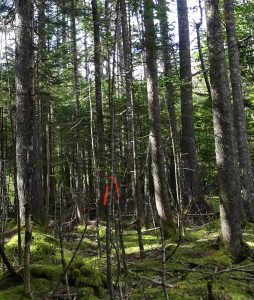The only place where employment has increased, when adjusted for the amount of area harvested, is in the wood product manufacturing industries and to a small extent in support activities for forestry. In other words, there is employment in the value-added sector.
He goes on to make a case for large trees:
We need to manage our forested lands not just as fibre, but for long-term gain in the growth of large trees. Large-diameter sawlogs are not as plentiful as they used to be but with proper management they could be. Thus they would support value-added industries and benefit employment. Furthermore, large trees could bring other benefits. Through carbon sequestration, they combat global warming, they have a myriad of ecological values and also will have a monetary value under a cap-and-trade system.
View OPINION: Forests need better management (Chronicle Herald, Nov 2, 2017)
One benefit of older trees: it makes better wood. When Amos Wood of Blockhouse got a contract to replace six pine windows for the historical St. Mary’s Basilica in Halifax, he could not replace them with local pine:
The windows will be constructed out of Sapele Mahogany, a hardwood from sub-tropical Africa. “Unfortunately,” says Amos of the material. “But it was less expensive than our Western Red Cedar, which would have been a good material to use, but cost ruled the day.” While the original windows were made of pine, Amos maintains that the pine available on the market today is “so young. “It simply doesn’t have the resistance factor that the slower growing, older wood from time ago had.” According to Amos, the forests are now working on a 60- to 80-year rotation, “which cannot give us 200-year-old wood.”
View Window of opportunity
(Article in LighthouseNow by Gayle Wilson Oct 11, 2017)
This comment followed a post about the article on Woods and Waters Nova Scotia:
DC: A poorer grade pine will grow up on the southwestern clearcuts, and will not be prized for the purposes this article addresses. Mills had best enjoy their “clear pine” while they still can. We know what the open grown pine looks like, full of knots and larger growth rings; generally poorer grade, and often hit by weevil, which ultimately reduces board footage. There will be far less quality pine grown from this point onward unless on private land by wise and more caring landowners. Current Crown land practices [referring to clearcutting on 50-60 year rotations] won’t grow quality pine unless by accident.
I have heard many comments over the past year about the poor quality of pine lumber available locally. Are we shipping the best of what we have left to the U.S.?
Is there a possibility that the poor quality of pine lumber locally will add to tariff-related incentives to import more pine lumber from western Canada, furthering our slide into a forest industry based primarily on low value-wood?
ADDENDUM Nov 4 …more from the discussion on Woods and Waters Nova Scotia:
October 25
SF (lumber Co): We saw quality eastern white pine everyday! We see lots of clears and have excellent grade recovery!AB: Thanks for your input, Steve. I’m not sure that this topic revolves around clear or not clear, or “quality” as it is defined/marketed by many of today’s mills. Perhaps this article might help: http://thecraftsmanblog.com/why-old-growth-wood-is-better/. It’s a great deal of fun looking at old wood from older structures and furniture, and provides an interesting perspective of NS forests, past to present.
SF: I didn’t figure you would want us touching old growth? The market for that kind of wood is extremely limited. There seems to be a belief that value is being left on the table but we are searching for this value daily. Our log handlers are trained to look for tone wood in our spruce piles but it is rare to find suitable wood. The value for these products is a nice boost but not material to our operation. If Jeff talked to us we would save logs for him but I’m not sure they saw anymore…
LikeShow more reactionsOctober 26 at 10:58am
AB: Old forests can be managed (forestry) to maintain old forest attributes, so I’m not sure how your question is contributing to this discussion of old wood. Feel free to clarify and I’m happy to comment. I believe this LighthouseNow article was intended to highlight the lack of shade-grown wood and/or old wood, which doesn’t necessarily involve old growth (although the Craftsman Blog does talk about it that way, but it was shared merely for discussion about the wood quality itself). It’s great that higher quality wood is being looked for in log piles and I commend those efforts. However, by the sounds of the discussion led by the Healthy Forest Coalition, I think the discussion may be best served steering more towards how trees are grown, or left to grow, versus what they look like in a pile. I’ll leave you with the last comment here, but thanks again for providing information.

